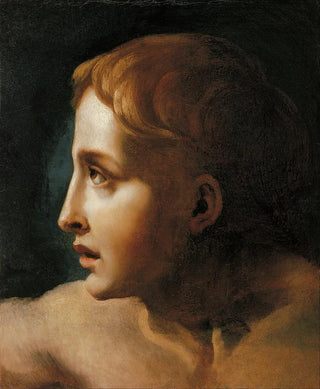Art print | Chef d'un jeune - Théodore Géricault


View from behind

Frame (optional)
In the vast panorama of art history, certain works stand out for their ability to capture the very essence of humanity. "Chef d'un jeune" by Théodore Géricault is one of those creations that provokes deep reflection on the human condition. This painting, imbued with sensitivity and power, transcends a simple portrait to evoke universal emotions. By contemplating this piece, the viewer is transported into a silent dialogue with the young model, whose intense gaze seems to bear the weight of the human soul. Géricault, master of Romanticism, manages to bring this representation to life, inviting each person to explore the nuances of youth, innocence, and vulnerability.
Style and uniqueness of the work
Géricault's style is characterized by bold use of light and shadow, creating a striking contrast that emphasizes the features of the young man's face. The chiaroscuro technique, so dear to the painter, adds emotional depth to the piece, making palpable the tension between light and darkness. The brushstrokes, both precise and expressive, testify to remarkable skill, while revealing a certain spontaneity. This stylistic choice contributes to the authenticity of the portrait, where every detail, from the piercing gaze to the nuances of the skin, seems to tell a story. The composition, focused on the face of the young person, invites intimate contemplation, allowing the viewer to question the thoughts and emotions that inhabit this enigmatic character.
The artist and his influence
Théodore Géricault, an emblematic figure of the Romantic movement, knew how to mark his era with works that challenge artistic conventions. His training with the great masters of the time, combined with a unique sensitivity, enabled him to develop a style that combines realism and expressionism. Géricault does not merely aim to depict external beauty; he seeks to reveal the complexity of the human soul through often dark and tragic themes. His influence extends beyond his time, inspiring many artists who, like him, sought to explore the depths

Matte finish

View from behind

Frame (optional)
In the vast panorama of art history, certain works stand out for their ability to capture the very essence of humanity. "Chef d'un jeune" by Théodore Géricault is one of those creations that provokes deep reflection on the human condition. This painting, imbued with sensitivity and power, transcends a simple portrait to evoke universal emotions. By contemplating this piece, the viewer is transported into a silent dialogue with the young model, whose intense gaze seems to bear the weight of the human soul. Géricault, master of Romanticism, manages to bring this representation to life, inviting each person to explore the nuances of youth, innocence, and vulnerability.
Style and uniqueness of the work
Géricault's style is characterized by bold use of light and shadow, creating a striking contrast that emphasizes the features of the young man's face. The chiaroscuro technique, so dear to the painter, adds emotional depth to the piece, making palpable the tension between light and darkness. The brushstrokes, both precise and expressive, testify to remarkable skill, while revealing a certain spontaneity. This stylistic choice contributes to the authenticity of the portrait, where every detail, from the piercing gaze to the nuances of the skin, seems to tell a story. The composition, focused on the face of the young person, invites intimate contemplation, allowing the viewer to question the thoughts and emotions that inhabit this enigmatic character.
The artist and his influence
Théodore Géricault, an emblematic figure of the Romantic movement, knew how to mark his era with works that challenge artistic conventions. His training with the great masters of the time, combined with a unique sensitivity, enabled him to develop a style that combines realism and expressionism. Géricault does not merely aim to depict external beauty; he seeks to reveal the complexity of the human soul through often dark and tragic themes. His influence extends beyond his time, inspiring many artists who, like him, sought to explore the depths






